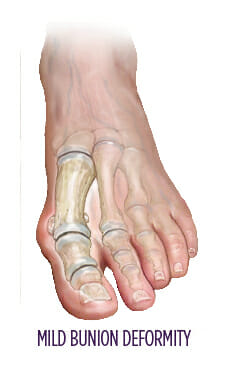
A bunion is a bony bump that forms on the joint at the base of your big toe. This joint is called the metatarsophalangeal (MTP) joint. When a bunion develops, the big toe joint starts to bend inward, pushing your toe toward the other toes. This can cause the metatarsal bone at the base of the big toe to stick out. The medical name for a bunion is hallux valgus.
Bunions can be uncomfortable and make walking difficult. At Summit Orthopedics, our foot surgeons and physicians in the Minneapolis/St. Paul area offer different treatments to get you back on your feet without pain and discomfort. We start with nonsurgical options or, if needed, explore surgery to help you find relief.
What Causes a Bunion?
Doctors aren’t completely sure what causes bunions, but they do know bunions may be more likely to form if:
- You wear shoes that do not fit your foot properly, such as tight shoes or those with a narrow toe area.
- You have family members with bunions, as your genetic makeup may influence whether you get bunions.
- You have a condition like rheumatoid arthritis. Bunions are common in people with rheumatoid arthritis because damage to the bottom joint of the big toe causes the toe to dislocate or shift. As it moves, it can crowd your other toes and move the big toe joint outward, forming a bunion.
- You have flat feet
While tight, narrow shoes may increase your risk of getting bunions, they are sometimes not the cause. Some people wear tight shoes all the time and never get bunions, while others who always wear comfortable, wide shoes still develop them.
Preventing Bunions: What You Can Do
You can help prevent bunions by wearing the right shoes. Your shoes should be wide enough for your feet and ideally have a low heel and a soft sole. Sometimes, a bunion continues to get bigger, even if you wear the right shoes. When that happens, the best next step is to talk with a doctor about your treatment options.
Bunion Symptoms: When to See a Doctor
In addition to causing toe deformity, bunions can also cause:
- Calluses on the bottom of your feet
- Pain
- Swelling
- Redness
- Tenderness
Bunions tend to worsen over time. Talk with your doctor if you think you’re developing a bunion. You should also see your doctor if you’re experiencing symptoms that interfere with daily tasks, walking or enjoying your favorite sports and activities.
Getting a Diagnosis
Your doctor can diagnose your bunion based on a physical exam. They may want to see how serious the deformity is and take a few X-rays of your foot. This allows them to fully understand the bony anatomy and confirm the type of bunion deformity you have. All of this information helps your doctor create the best treatment plan for you, which can include shoe inserts or surgery.
Bunion Treatment Without Surgery
Treating a bunion early can make a difference in how you manage it. Your doctor may suggest some simple changes that may ease your symptoms and eliminate your need for surgery:
- Change your shoes. Choosing shoes that fit well and have a wide, roomy front is key. Avoid high heels and shoes with a narrow toe box to stop the bunion from getting worse.
- Use special pads and tape. Your doctor might give you a special pad to place over the bunion. They can also show you how to tape your toe to help keep it in a better position.
- Take over-the-counter medication.Medications like ibuprofen and naproxen can offer relief from pain and swelling.
Sometimes, these changes are enough to manage a bunion. If your symptoms continue or get worse, you may need surgery.
Surgical Treatment
Your doctor might suggest bunion surgery if other treatments don’t improve your symptoms. The main goals of surgery are to relieve pain and straighten your bones.
There’s more than one type of bunion surgery. They can involve:
- Cutting and realigning the bones
- Fusing the joint surfaces, a procedure that is used for more severe cases
- Removing the bony bump, which is rarely done on its own
Your orthopedic surgeon will talk with you about your options and help you find the best approach.
Recovery after bunion surgery depends on factors like the type of surgery you had and how closely you follow your doctor’s follow-up care. They will let you know when you can put weight on your foot again. You will likely need to use crutches or a knee walker to get around.
After bunion surgery, you’ll have regular follow-up appointments for several months—sometimes up to a year—to make sure everything is healing correctly.
Expert Care for Bunions at Summit Orthopedics
Your orthopedic surgeon is an expert in treating bunions and will help you find the best treatment. They will first try to find a nonsurgical option that works for you. If you need surgery, we use the latest and most effective methods. You can count on your care team to guide you through every step, from diagnosis to treatment and recovery.
Summit Orthopedics surgeons are available at nearly 30 convenient locations across the Minneapolis/St. Paul metro area, serving Minnesota and western Wisconsin. Our state-of-the-art, comprehensive orthopedic centers offer same-day appointments from a team of experts who offer the full scope of orthopedic care.
Find your Summit Orthopedics foot expert, request an appointment or call us at (651) 968-5201 to schedule a consultation.
